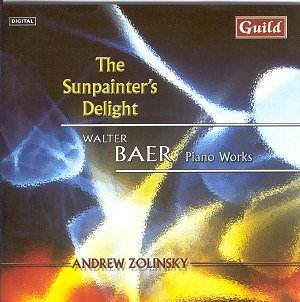The earliest works here, both dating from 1968, obviously
belong to Baer’s modern or experimental period, and are stylistically
redolent of Boulez or Stockhausen. Angular phrases, complex rhythms
and sharp contrasts characterise both Sequenzen and Zwei
Klavierstücke, though the latter already points towards
a freer expression, particularly so in the first piece Threnos.
All the other pieces are fairly recent and clearly
reflect Baer’s stylistic journey towards a more colourful and more expressive
palette. The music of Passagen, composed between 1996
and 1998, is more overtly impressionistic. This is quite evident in
Passagen III, and still more so in its third movement
Souvenir. "It is up to the listener to draw his own reminiscences
from the character of the piece" (pace the composer). This
seems to me a homage to Debussy. (It may also be useful to know that
the titles of the three movements are in French and that the second
movement is inspired by a walk in a park in Paris known as La promenade
plantée.) Other movements in Passagen also
betray their inspirational origin in painting, e.g. Sonnenbild
(in Passagen I) or The Painter’s Delight (in Passagen
II), both inspired by paintings by Hoenich. Instrumental colour
is paramount in these works and it is sometimes achieved by some extra-musical
devices, such as in the third piece Epitaph for Anton Webern
(in Passagen I) in which the outer, chorale-like sections
have an eerie tint obtained by laying a stick over the strings. This
is actually the only "gimmick" used by the composer, and quite
discretely so.
The most recent work, Erscheinungen from
2000, is a substantial piece of music, and incidentally the longest
single item. Its title (i.e. Visions) has no religious or mystical
overtones, but rather refers to the mysterious chorales emerging on
several occasions in the course of the piece between the other, livelier
and more animated sections. Again, the listener’s fancy may imagine
his/her own visions; but the inspiration for the music draws again on
Hoenich’s paintings.
Walter Baer’s name and music were, I confess, completely
new to me. Eminently idiomatic, though often rather taxing piano writing
that calls for much colour, imagination and tonal variety on the performer’s
part. Andrew Zolinsky obviously possesses all the qualities required
to get the best of these fine and attractive pieces that generously
repay repeated hearings. Now, I really look forward to hearing more
of Walter Baer’s music.
Hubert Culot
But Gary Higginson asks
Question. What kind of music would a man born in Zurich in 1928 compose?
Time up. I shall reveal the answer in due course.
Stockhausen was born then, Henze in 1926, Berio in 1925. It’s useful
to think of Baer, who is a well known figure in German musical life
in this context because his music is mostly not at all what you might
expect. The biographical notes in the booklet comment "The various
compositional techniques and systems only make sense to me if they convey
a message the listener can participate in". He ends up being one
of the most eclectic composers I have ever encountered. I’ll talk you
through a few pieces to give you an idea.
‘Passagen’, probably best translated not as passages, which conveys
little, but as possibly, pathways, and like all paths they lead
to somewhere else. Each path though is enjoyable in itself, but there
is no attempt by the composer to connect them, at least not in a way
that I could discover. So ‘Passagen I’ begins with ‘Widmung’ meaning
‘Dedication’, here to the musical pedagogue Wolfgang Roscher whose name
is spelt out in the music. The style or soundworld of this piece reminds
me of Bartók in places, and a brief fugue develops based on these
letters, perhaps another Bartókian idea. It winds chromatically
in a rather learned way in four parts. At its climax unison figure announces
the end of the fugue and the movement winds up quickly. The second movement
‘Sunpainting’ is impressionistic; it is inspired by the work of the
painter P.K. Hoenich and obviously is partly responsible for giving
the CD its title. A wash of right hand semi-quavers and/or tremolandi
accompany a left-hand melody not unlike the chimes of Big Ben. Debussy
might be brought to mind, but a watered-down Debussy.
Movement 3 ‘Epitaph for Anton Webern’ starts off with a gamelan noise.
Some of the strings of the piano have been laid over with a stick, and
both of these things remind me more of John Cage. The stick is then
removed and the composition becomes pointillistic, not completely atonal,
but more Webern. It is the longest of the three in the set. The opening
returns for the last minute or so.
Other pieces on the disc include another impressionist interpretation
of the work of Hoenich, - movement 3 of ‘Passagen II’ entitled the ‘Sunpainter’s
Delight’; Movement 2 is an evocative re-enactment of the bells of the
composer’s hometown, Zurich, with its myriad bells ringing out.
Passagen III opens with a wash of French type sound, which is in fact
in homage to J.S. Bach with the B.A.C.H motif used throughout. For me
though, Ravel was brought to mind.
I hope that I have conveyed some impression of the music and its background.
I’m sorry to say that for me it lacks structural integrity and a real
character of its own. Although the music is rarely unattractive it can
often be dull and repetitive.
The booklet notes written by the composer are too succinct to be really
useful. The playing of Andrew Zolinsky is exemplary and he seems really
to believe in the music and is, anyway, a regular performer of contemporary
music. The recording is perfectly good and only enhances the music.
But there is little here I feel to retain much interest.
Gary Higginson


